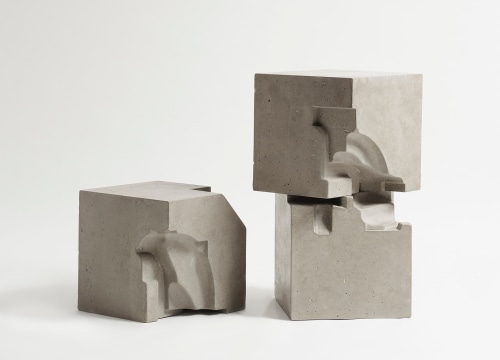
Medium: Borosilicate glass, bronze
Dimensions: 14 in high x 48 in wide
Mura low table is created in collaboration with Toronto-based glass design and fabrication atelier Jeff Goodman Studio (JGS). It pairs STACKLAB’s signature solid-bronze Jupiter leg castings with a droplet-shaped top of kiln-fused Temple glass. The table’s name derives from the Japanese word for “unevenness, irregularity, inequality.”
Temple glass is a handmade product invented by JGS for the Bahá’í Temple of South America, capable of withstanding the rigorous weather fluctuations and seismic activity of the Andes mountains near Santiago, Chile. In the proprietary fabrication process, rods of glass are broken. The glass fragments are arranged in the kiln bed in JGS’s randomized River Rock pattern, then fired and cooled for a week. This process yields a distinctive mottled motif of milky translucent veils within a transparent field.
The slab is polished, then cut to size with a water jet. Because the glass is handmade, each table top takes three weeks to carve and polish, a process that is impossible to duplicate, making each Mura table unique.
“Our studios share a love of controlled, but partially unknown, outcomes,” says STACKLAB Founder and Creative Director Jeffrey Forrest. “Our disciplined methods allow us to ‘let go’ as we approach the finish line and observe what happens, from a careful arrangement of glass rods settling in the kiln to a computer code interpreting inputs about form.”
“STACKLAB came to us with the idea of shaping the edge of Temple glass with a beautiful ribbon line,” says JGS Executive Director Sylvia Lee. “This is the first piece we’ve done in carved, sculptural Temple glass; earlier applications were always with straight edges. STACKLAB is helping push us into exploring the material more deeply and at a large scale. That’s exciting.”
As for the Jupiter leg, it is a study in creating a completely asymmetrical, yet aesthetically cohesive, geometry. The shape is readily castable, yet differs in every elevation, section and plan view. The sand-casting process produces faintly perceptible irregularities that enhance the leg’s tactile appeal. The planetary name pays homage to the subtitle of Mozart’s last symphony, a favorite of the client who commissioned the first Jupiter table.
The leg’s shape was digitally derived. A computer code was written that enabled the production of iterations that vary according to varying input parameters. Being able to iterate quickly allowed for the right balance among parameters.
The leg’s theme of asymmetry influenced STACKLAB’s design for the tabletop shape, which varies in every elevation, section and plan. The top appears different when looked at from above the flat top or through the sloping edge.
The Mura table will be produced in a limited-edition run of 25 units and available exclusively at Maison Gerard.
Jeff Goodman Studio, based in Toronto, has been internationally recognized for its modern blown glass vessels and innovative architectural glass. Every piece created is one-of-a-kind and handmade in its studio hot shop or kiln shop.